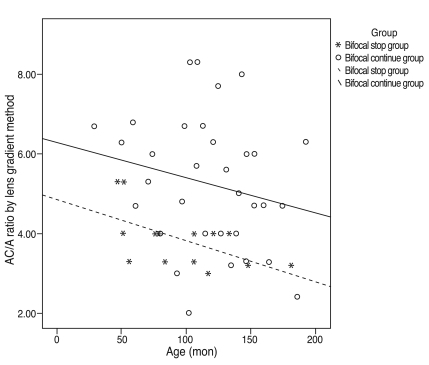Korean J Ophthalmol.
2012 Feb;26(1):39-44. 10.3341/kjo.2012.26.1.39.
The Analysis of AC/A Ratio in Nonrefractive Accommodative Esotropia Treated with Bifocal Glasses
- Affiliations
-
- 1B&VIIT Eye Center, Seoul, Korea.
- 2The Institute of Vision Research, Department of Ophthalmology, Yonsei University College of Medicine, Seoul, Korea. 491209@yuhs.ac
- 3Department of Ophthalmology, Aju University College of Medicine, Suwon, Korea.
- KMID: 1120180
- DOI: http://doi.org/10.3341/kjo.2012.26.1.39
Abstract
- PURPOSE
To report the long term results of bifocal treatment in nonrefractive accommodative esotropia and to analyze the changes of accommodative convergence to accommodation (AC/A) ratio.
METHODS
Sixteen patients treated with bifocal glasses for at least 5 years were evaluated retrospectively. Angle of deviation at near and distance, refractive error, and AC/A ratio by the lens gradient method were analyzed. The changes of AC/A ratios were also compared after dividing the patients according to continuation or cessation of bifocal therapy.
RESULTS
Six patients (38%; bifocal stop group, BSG) were able to stop using bifocal glasses at an average age of 10.8 years (range, 6.5 to 15.4 years) during their follow-up. However, the other ten patients (62%; bifocal continue group, BCG) had to continue using bifocal glasses until the final visit, which was 13.8 years on average (range, 11.3 to 18.5 years). The AC/A ratio decreased from time of bifocal prescription to the last visit in both groups, from 4.4 to 2.7 in the BSG and from 5.9 to 4.5 in the BCG. AC/A ratios were significantly higher (p = 0.03) in the BCG than that of the BSG from the beginning of bifocal treatment and this difference was persistent until the final visit (p = 0.03).
CONCLUSIONS
The AC/A ratio decreased with age in both groups but was significantly higher throughout the entire follow-up period in the BCG. AC/A ratio at bifocal prescription could be an important factor in predicting response to bifocal treatment.
Keyword
MeSH Terms
Figure
Cited by 1 articles
-
The Ratio of Accommodative-Convergence to Accommodation in Patients with Nonrefractive Accommodative Esotropia
Rebecca Kim, Se Youp Lee
J Korean Ophthalmol Soc. 2014;55(2):267-270. doi: 10.3341/jkos.2014.55.2.267.
Reference
-
1. Bruce AS, Atchison DA, Bhoola H. Accommodation-convergence relationships and age. Invest Ophthalmol Vis Sci. 1995; 36:406–413. PMID: 7843910.2. Ciuffreda KJ, Rosenfield M, Chen HW. The AC/A ratio, age and presbyopia. Ophthalmic Physiol Opt. 1997; 17:307–315. PMID: 9390375.
Article3. Mutti DO, Jones LA, Moeschberger ML, Zadnik K. AC/A ratio, age, and refractive error in children. Invest Ophthalmol Vis Sci. 2000; 41:2469–2478. PMID: 10937556.
Article4. Eckstein AK, Fischer M, Esser J. Normal accommodative convergence excess: long-term follow-up of conservative therapy with bifocal eyeglasses. Klin Monbl Augenheilkd. 1998; 212:218–225. PMID: 9644668.5. Yu G. The correction of high AC/A ratio non-accommodative esotropia with straight-top bifocals. Zhonghua Yan Ke Za Zhi. 1993; 29:343–345. PMID: 8020376.6. Rich LS, Glusman M. Tangent Streak RGP bifocal contact lenses in the treatment of accommodative esotropia with high AC/A ratio. CLAO J. 1992; 18:56–58. PMID: 1559291.7. Procianoy E, Justo DM. Results of unilateral medial rectus recession in high AC/A ratio esotropia. J Pediatr Ophthalmol Strabismus. 1991; 28:212–214. PMID: 1919968.
Article8. Pratt-Johnson JA, Tillson G. The management of esotropia with high AC/A ratio (convergence excess). J Pediatr Ophthalmol Strabismus. 1985; 22:238–242. PMID: 4078665.
Article9. Pratt-Johnson JA, Tillson G. Sensory outcome with nonsurgical management of esotropia with convergence excess (a high accommodative convergence/accommodation ratio). Can J Ophthalmol. 1984; 19:220–223. PMID: 6478307.10. Ludwig IH, Parks MM, Getson PR. Long-term results of bifocal therapy for accommodative esotropia. J Pediatr Ophthalmol Strabismus. 1989; 26:264–270. PMID: 2621544.
Article11. Lueder GT, Norman AA. Strabismus surgery for elimination of bifocals in accommodative esotropia. Am J Ophthalmol. 2006; 142:632–635. PMID: 17011856.
Article12. Kushner BJ. Fifteen-year outcome of surgery for the near angle in patients with accommodative esotropia and a high accommodative convergence to accommodation ratio. Arch Ophthalmol. 2001; 119:1150–1153. PMID: 11483081.
Article13. Arnoldi KA, Tychsen L. Surgery for esotropia with a high accommodative convergence/accommodation ratio: effects on accommodative vergence and binocularity. Ophthalmic Surg Lasers. 1996; 27:342–348. PMID: 8860599.
Article14. Clark RA, Ariyasu R, Demer JL. Medial rectus pulley posterior fixation is as effective as scleral posterior fixation for acquired esotropia with a high AC/A ratio. Am J Ophthalmol. 2004; 137:1026–1033. PMID: 15183786.
Article15. Gharabaghi D, Zanjani LK. Comparison of results of medial rectus muscle recession using augmentation, Faden procedure, and slanted recession in the treatment of high accommodative convergence/accommodation ratio esotropia. J Pediatr Ophthalmol Strabismus. 2006; 43:91–94. PMID: 16598975.
Article16. Franceschetti AT, Burian HM. Gradient accommodative convergence-accommodative ratio in families with and without esotropia. Am J Ophthalmol. 1970; 70:558–562. PMID: 5505472.
Article17. Havertape SA, Cruz OA, Miyazaki EA. Comparison of methods for determining the AC/A ratio in accommodative esotropia. J Pediatr Ophthalmol Strabismus. 1999; 36:178–183. PMID: 10442723.
Article18. Risovic D. Treatment of esotropia with a high AC/A ratio. Srp Arh Celok Lek. 2003; 131:36–39. PMID: 14608860.19. Von Noorden GK, Morris J, Edelman P. Efficacy of bifocals in the treatment of accommodative esotropia. Am J Ophthalmol. 1978; 85:830–834. PMID: 677210.
Article20. Semmlow J, Putteman A, Vercher JL, et al. Surgical modification of the AC/A ratio and the binocular alignment ("Phoria") at distance; its influence on accommodative esotropia: a study of 21 cases. Binocul Vis Strabismus Q. 2000; 15:121–130. PMID: 10893454.
- Full Text Links
- Actions
-
Cited
- CITED
-
- Close
- Share
- Similar articles
-
- The Ratio of Accommodative-Convergence to Accommodation in Patients with Nonrefractive Accommodative Esotropia
- Clinical Studies on Accormmodative Esotropia
- Clinical Assessment of Accommodative Esotropia
- Clinical Characteristics of Accommodative Esotropia with Successful Wearing out of Glasses
- Predictive Factors of Successful Weaning From Glasses in Accommodative Esotropia Patients


